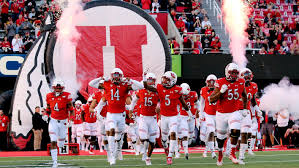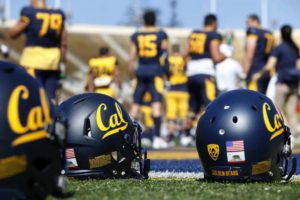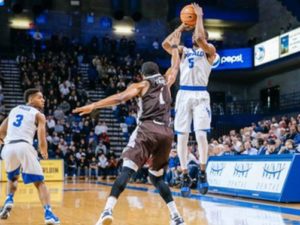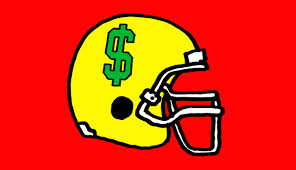It’s not a sports story. It’s a public policy problem. Here’s why.

Courtesy: utahutes.com
Fielding major college sports teams is an attractive, value-added proposition for America’s colleges and universities. Research shows that athletic success enhances a school’s brand, attracts more and better students, invites more donor dollars, and generates more press coverage. It’s one reason why there are more football-playing colleges and universities today than ever before.
But a question looms large: Who pays for college sports at America’s major and mid-major public sports-playing schools?
That IS a big question because the system requires big money to exist. How big? USA Today tracks the numbers annually, and the newspaper just released results for the 2017-18 year. For that reporting period, America’s 230 major and ‘mid-major’ public universities generated over $11 billion in revenues and spent almost all of the money they took in. (Note: Private institutions, such as Notre Dame, Duke, and Stanford, are not required to submit data.)
But amid all that money an issue lurks. It’s called subsidies to athletic revenues. Those dollars–added to the athletic revenue ledger–come primarily from all-university funds and student fees. Last year, nearly $3 billion of the $10 billion in athletic revenues came from subsidies.
But make no mistake about one thing—and it defines the reality context of college sports in America today. Some schools need more subsidy money than others … a lot more. Which ones? Let’s look at the numbers to find out.
Most schools in America’s top athletic conferences—the Big Ten, Big 12, Pacific-12, Atlantic Coast, and Southeastern conferences—don’t need much, if any, subsidy support. That’s because those schools generate considerable revenue from athletic ticket sales, TV and other media revenue, conference allocations, merchandising, and donor contributions to athletics.

Courtesy: sfgate.com
For the most recent period reported by USA Today, 12 schools—Arkansas, Cal, Kentucky, LSU, Nebraska, Ohio State, Oklahoma, Penn State, Purdue, South Carolina, Texas, and Texas A&M—required no athletic subsidies to operate their athletic programs. Another 24 schools, including Iowa, Oregon, and Tennessee, generated 95%+ of athletic revenues through athletic-related means. And another 8 institutions, including Georgia Tech, Illinois, and Florida State, covered 90%+ of athletic revenues that way.
Those 44 schools are among the country’s most familiar collegiate brands. They are also among “the have’s” (in money terms) of college sports.
At the other end of the spectrum resides the majority of America’s 230 public sports-playing schools–institutions that can’t make ends meet without the infusion of substantial subsidies. Most are lesser-known names in collegiate sports, including–at the top of this year’s subsidies list–Cal-Riverside, New Jersey Tech, Indiana-Purdue Indianapolis, Utah Valley, and Longwood. At those five schools, the median contribution of subsidies to athletic revenues was 89.2%. That means nearly 90 cents of every dollar of ‘athletic’ revenues came from non-athletic sources. In total, those five schools added $68.5 million in subsidies to their sports budgets.

In 2017-18, subsidies to athletics at SUNY Buffalo totaled $31 million, which ranks 7th highest among 230 schools in USAToday’s database. James Madison is #1 at $42 million, followed closely by Air Force and UConn. At UB, subsidies account for 75% of the school’s athletic revenues (photo, Bulls’ star CJ Massinburg in action, via UB Athletics).
In all, over 30 schools rely on subsidies that account for at least 80% of total revenues. That list includes Wright State, Stephen F. Austin, and Sacramento State. Another 25 schools need at least a 75% boost by way of subsidies. That list includes SUNY Binghamton, Indiana State, and Troy, And another 50+ schools require at least 65% in subsidies to make a go of it. That list includes Maine, Northern Colorado, and Middle Tennessee.
In all, 150 schools had at least 50% of athletic revenues come via subsidies. Those 150 schools are among America’s ‘have not’s’ (in money terms) sports universities.
A deeper dive into the data provides more detail about America’s two-tier college sports systems. Subsidies at the 20 public universities that need the least amount of subsidies total under $3 million. Subsidies at the 20 public universities that need the most subsidies total over $305 million.
Perhaps an even more striking comparison involves looking at total athletic revenues at those 20 + 20 schools. Total athletic revenues are $2.88 billion at the 20 schools that need the least amount of subsidies. Total athletic revenues are $357 million at the 20 schools that need the most subsidies. In other words, schools with smaller athletic budgets generally need more subsidy assistance, and schools with larger athletic budgets generally need less subsidy assistance.
That contrast holds up when you compare major and mid-major schools located in the same state. Here are a few examples. In South Carolina, subsidies are critical at Coastal Carolina (76% subsidy), but not at Clemson (4.5% subsidy). Balancing the budget with subsidies is necessary at South Alabama (76%), but not at Alabama (1.5%). Portland State (76%) needs subsidies, but Oregon (.2%) does not. The same pattern holds in Florida (U. of Florida, 1.45%, and Florida International, 73%), and California (California-Berkeley, 0%, and Cal-Davis, 82%).
Overall, state taxpayers and students are carrying a significant financial burden in states that have a number of publicly-supported, mid-major athletic programs. That list includes California, Florida, Michigan, Ohio, and Virginia.
Consider this headline from the Detroit Free Press: “How much cash should Michigan universities pour into athletics?” A good question, let’s look at the Wolverine state’s two-tier college sports system.
The state’s two major programs—Michigan and Michigan State—run large athletic programs (combined revenues of $342 million in 2017-18) with subsidies totaling $1.6 million. In contrast, $90 million in subsidies were required to run the state’s four mid-major programs at Oakland, Western Michigan, Eastern Michigan, and Central Michigan. In 2017-2018, those four schools had combined athletic revenues (excluding subsidies) of $33.4 million.
Think about that for a minute.
The four mid-major sports programs in Michigan consumed $90 million in non-athletic subsidies to athletics, while they generated $33 million in revenues from athletics sources. That means about $3 of every $4 athletic revenue dollars came from non-athletic sources.
What’s even more troubling is that Michigan isn’t a one-off. You’ll find the same pattern in other states.
This, I believe, is an untenable situation for public institutions and, as a professor emeritus, I believe it’s an embarrassment to public higher education. While I support the right of universities to make financial decisions, there are other issues to be considered. A big issue is the broader economic environment associated with higher education today. State allocations to public universities have been under pressure for years, college costs are at historic highs, and so is student debt. This is no time to throw millions and billions of discretionary dollars at college athletics.
 The unfortunate part of this tale is the subsidy pattern just reported hasn’t changed over the years. I’ve been reporting this story since 2014. Back then, athletic revenues for major and mid-major public schools totaled $7.8 billion, and the schools spent nearly every cent of what they brought in. Of that, $2.4 billion came via subsidies. Today, it’s $11 billion in revenues, spending that equals revenues, and athletic subsidies at $3 billion.
The unfortunate part of this tale is the subsidy pattern just reported hasn’t changed over the years. I’ve been reporting this story since 2014. Back then, athletic revenues for major and mid-major public schools totaled $7.8 billion, and the schools spent nearly every cent of what they brought in. Of that, $2.4 billion came via subsidies. Today, it’s $11 billion in revenues, spending that equals revenues, and athletic subsidies at $3 billion.
Five years later, the storyline remains unchanged.
–Schools keep spending more and more on sports.
–The gap between ‘have’s and have not’s” persists.
–The NCAA does nothing of consequence to control athletic spending or address the subsidy issue.
No wonder there is persistent interest in establishing Federal-level oversight of college athletics. Like-discussions are also underway in several states (e.g., NC Senate Bill DRS35135-TCz-8).
I’m not arguing that college athletics should be self-supporting. What I am saying is that the system is out-of-whack. Reasonableness needs to be a guiding principle.
The general public and state legislators across the country need to ask if athletic subsidies are a good way to spend billions of public dollars nationally each and every year. The keywords are ‘each and every.’ Consider the data I reported for the State of Michigan earlier. Then project that subsidy amount over a decade. If you’re like me, it will make your head spin.
What’s the take-away message? Public subsidies in college sports aren’t just a sports story. They are a public policy problem.
Many schools want all the benefits enjoyed by big sports-playing schools, but they end up living well beyond their means.
Keep all of this in mind the next time you attend a football game at XYZ State and watch the action in a half-empty stadium. Wonder how things get paid for? Now you know.
Resolving the problem is straightforward, albeit difficult to implement. It costs a ton of money for schools to compete at the highest level of intercollegiate athletics. Many schools moved aggressively over the past decade or so to attain that level. It’s time to reverse direction. I endorse campus conversations (and protests), such as those that have taken place at Eastern Michigan, regarding better aligning competition level with ability to pay. It will mean dropping down a level (perhaps two) in NCAA play and, for some, it will mean eliminating the most expensive sport, which is football.
Otherwise, the pattern I’ve described will only get worse.
_______________
NOTE: I wrote this commentary because I wonder, these days, about the fundamental purpose of higher education. The corporatization.commercialization of higher education (of which revenue-generating athletics is a dominant feature) makes it more difficult for higher education to function as the social institution society needs and deserves.



